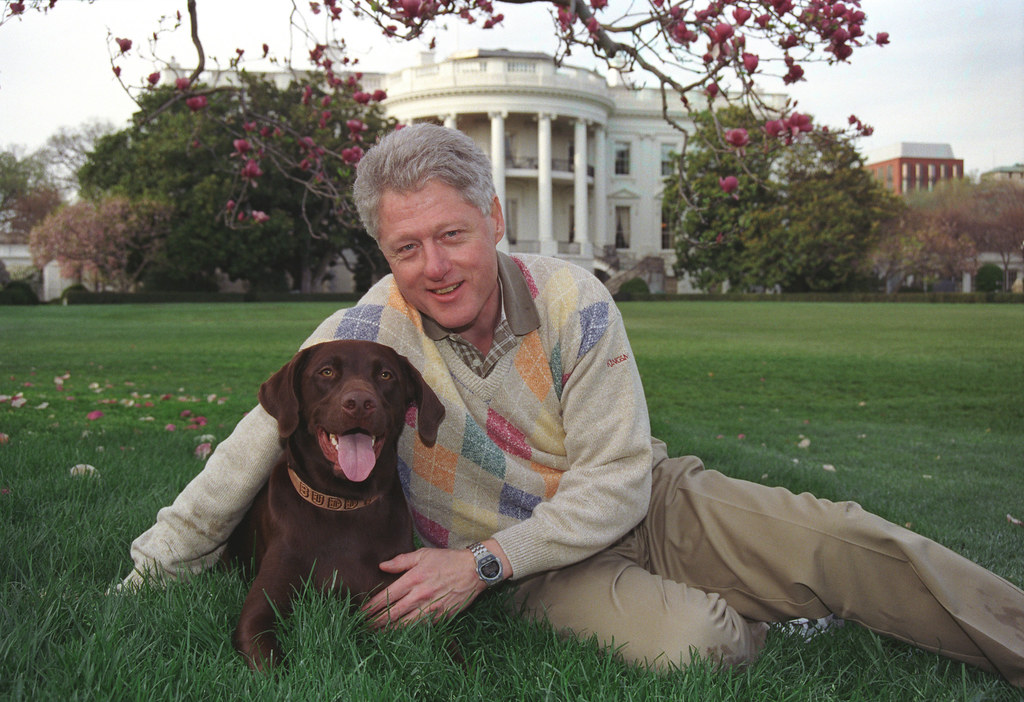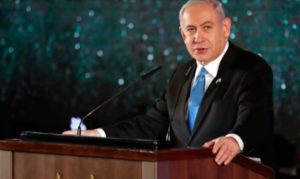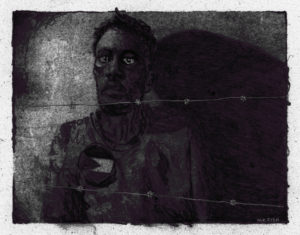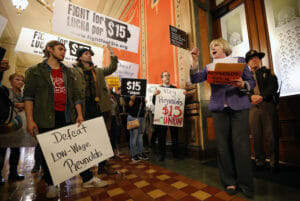American History for Truthdiggers: Bill Clinton, the ‘New Democrat’
His two terms were marked by partisan rancor, scandal and, for many Americans, betrayal by the president. Bill Clinton on the White House lawn with Buddy in 1999. The 42nd president served from 1993 to 2001. (U.S. National Archives / Creative Commons)
Bill Clinton on the White House lawn with Buddy in 1999. The 42nd president served from 1993 to 2001. (U.S. National Archives / Creative Commons)
Editor’s note: The past is prologue. The stories we tell about ourselves and our forebears inform the sort of country we think we are and help determine public policy. As our current president promises to “make America great again,” this moment is an appropriate time to reconsider our past, look back at various eras of United States history and re-evaluate America’s origins. When, exactly, were we “great”?
Below is the 35th installment of the “American History for Truthdiggers” series, a pull-no-punches appraisal of our shared, if flawed, past. The author of the series, Danny Sjursen, who retired recently as a major in the U.S. Army, served military tours in Iraq and Afghanistan and taught the nation’s checkered, often inspiring past when he was an assistant professor of history at West Point. His war experiences, his scholarship, his skill as a writer and his patriotism illuminate these Truthdig posts.
Part 35 of “American History for Truthdiggers.”
See: Part 1; Part 2; Part 3; Part 4; Part 5; Part 6; Part 7; Part 8; Part 9; Part 10; Part 11; Part 12; Part 13; Part 14; Part 15; Part 16; Part 17; Part 18; Part 19; Part 20; Part 21; Part 22; Part 23; Part 24; Part 25; Part 26; Part 27; Part 28; Part 29; Part 30; Part 31; Part 32; Part 33; Part 34.
* * *
He was bright, he knew the details of domestic policy in and out, and he was a natural politician. William Jefferson Clinton, the “man from Hope,” Ark., grew up poor and rose to spectacular and unexpected heights. But he was also deeply insecure and obsessively needed to be liked, and, ultimately, it was unclear just what, if anything, the man believed in. Although Bill Clinton dreamed of being a great president, in the vein (he thought) of John F. Kennedy and Franklin D. Roosevelt, his abundant ambition was not enough to produce that result. But whatever his failures as a leader and a person, he reached voters, “felt their pain” and, on the surface at least, seemed to possess a common touch, an everyman empathy that drew multitudes to him. Having grown up among black people in Arkansas, he seemed particularly comfortable around African Americans, leading the famed novelist Toni Morrison to dub him “the first black president.” In time, she, and many of her fellow African Americans, undoubtedly came to regret those words as Clinton’s rather conservative, “New Democrat” policies proved to be disastrous for most blacks in the United States.
Clinton loved politics; he was known to talk endlessly into the night about the intricacies of policy. However, that mastery did not extend to his abilities as a boss. He had an awful temper, often lashed out at staff and seemed ill-disciplined and out of his depth early in his first term. Many staff members found him self-pitying, narcissistic and laser-focused not on values or issues but on opinion polls, his own political standing and re-election. Clinton was perhaps America’s first permanent campaigner president, setting the tone for his copycat successors in an age of tribal political partisanship. He was good at it too. A master of media “spin” and carefully crafted talking points, it was no accident that he would quickly be nicknamed “Slick Willie.”
Perhaps the depth of his character flaws was no more severe than that of presidents before him (one thinks of JFK’s scandals with medication and women), but Clinton occupied the Oval Office at a time when the media was far less likely than in earlier generations to defer to authority figures and look the other way. He was under a microscope for eight straight years, and what the public found was often disturbing. His personal foibles and dubious character traits were perhaps best summarized by Michiko Kakutani of The New York Times at the end of the second term. “In his adolescent craving to be liked …,” Kakutani wrote, “and the tacky spectacle of his womanizing, Mr. Clinton gave us a presidency that straddled the news pages and the tabloid gossip columns.” How accurate that assessment was, and how well it could be applied to the current chief executive!
The ascendant political right—in Congress, the conservative media and the pulpits of evangelical mega-churches—absolutely loathed the man, and even more so his ambitious wife, Hillary. Republicans exaggerated, cried wolf, one might say, depicting the Clintons as extreme leftists out of touch with middle (“real”) America and, indeed, even unpatriotic. They stifled the president at nearly every turn, at least when he attempted even marginally liberal policies. Yet just as often the conservatives sided with him, forming alliances of convenience, as Clinton showed his true colors, which were centrist and even right-leaning. Indeed, it would be apparent, in hindsight, that the 42nd president was the first outright neoliberal chief executive, tacking right time and again and paving the way for the rise of neoconservative Republican power.
Perhaps it should have been little surprise that Clinton never lived up to his idols, JFK and FDR, or managed to bolster the standing of the flailing Democratic Party. After all, in a three-way race, Clinton earned only 43 percent of the popular vote in winning his first presidential term in 1992. This meant that 57 percent of Americans voted for the Republican George H.W. Bush or the fiscally austere deficit hawk Ross Perot, who ran as a third-party candidate.
Clinton was truly a new breed of Democrat. More interested in winning than liberal dogma, he read the tea leaves of the “Reagan Revolution” and decided to undercut his conservative opponents by taking right-facing positions. Did he really believe that such once-Republican policies were in the nation’s best interest? Or did he just do what was necessary to win? The question will undoubtedly be argued forever. What’s certain is Clinton did not occupy the liberal ground once traveled by George McGovern, or even Jimmy Carter. He was a corporate Democrat, one who deftly convinced all parties in the waning Democratic coalition that he was “on their side,” while often selling them out soon afterward. This went for blacks, Hispanics, gays, union workers and the very poor. Clinton even spoke differently depending on his audience, managing, despite his inconsistent policies, to win the adoration of many of those he would abandon once in the White House.
Whereas Republicans were once seen as the “big money” party, Bill Clinton carried 13 of the 17 most affluent congressional districts in the 1996 election. Was liberalism dead? Maybe. It was, no doubt, at least in remission. The canny Clinton could stymie the Republicans, to their utter frustration, but he was more often than not the slave of the conservative majority on Capitol Hill and the (white) conservatives in an increasingly right-leaning populace. The least among the American people, theoretically the beneficiaries of the political left, did not gain from the Clinton years. The rich became richer, the poor poorer, and through a slew of neoliberal policies, Clinton managed to cede victory to the prevalent ideas of the conservative right. The consequences were often severe.
Clinton at Home: Neoliberalism Ascendant
Clinton ran as a centrist in 1992 but depicted himself as more fiscally conservative than GOP rival George H.W. Bush and promised to “end welfare as we know it.” He sometimes sounded as though he had co-opted the right’s message and its favorite talking points. Still, early in his first term, Clinton attempted two relatively liberal actions: health care reform and ending the military’s ban on gay members. He was rebuked on both counts. In the arena of health care, Republicans, more-conservative Democrats and powerful insurance industry lobbyists counterattacked, ran millions of dollars worth of negative ads and ultimately killed the liberal dream of universal medical insurance that had existed at least since the administration of Harry Truman. The defeat was a political embarrassment to the first lady, whom Clinton had tapped to lead the endeavor. More worrisome were the stark outcomes. Some 30 million Americans had no health care coverage at all, and U.S. infant death rates and other key health indices were at deplorable levels. Nearly all other industrialized countries had full coverage for their citizens and superior health outcomes.
When Clinton sought to end the ban on gays serving in the military, once again he ran up against a congressional coalition, this time one joined by senior military officers including Chairman of the Joint Chiefs Colin Powell. Their fierce opposition spooked the president, who agreed to a compromise policy known as “don’t ask, don’t tell.” Under a spectacularly vague statute, service members were not to reveal their sexual preference and military leaders were not to inquire. Still, an admission of homosexuality or discovery of a gay sexual act would still lead to dismissal from the military. In following years, more than 10,000 gays were discharged from the service, a disproportionate number of whom filled the paltry, but vital, ranks of linguists and foreign area experts. In the wake of the terror attack of Sept. 11, 2001, the military would desperately miss those troopers. Then, in a final abandonment of gays, Clinton signed the Defense of Marriage Act, a federal law that allowed states not to recognize out-of-state same-sex marriages and defined (from a federal perspective) the institution as a union between “one man and one woman.” The number of Democrats who supported or acquiesced to such discriminatory legislation demonstrated the prevailing and persistent social conservatism of the times.
After the debacles involving gays in the military and health care, and after Republicans swept to victory in the 1994 congressional midterm elections, Clinton went fully neoliberal, abandoning almost every traditional liberal cause. Over the complaints of unions and manufacturing workers, he would sign the North American Free Trade Agreement (NAFTA), which Bush had negotiated. Indeed, as pro-labor elements had feared, many companies would move to the cheap-labor environments of Mexico and elsewhere. Additionally, Clinton supported the racially charged crime bill that Democratic Sen. Joe Biden had shepherded through Congress. Defended with academically debunked charges—which Hillary Clinton repeated—about the existence of young “super-predators” in the inner cities, the crime bill was a disaster for the urban poor, especially blacks. The legislation delivered a blow to opponents of the death penalty (it limited appeals and decreased the time between conviction and execution), eliminated federal parole, encouraged states to take similar steps, and instituted “three strikes” programs (whereby a third felony conviction automatically led to life imprisonment), harsh mandatory minimum sentences and even new disparate sentencing guidelines for certain classes of narcotics. Specifically, possession of crystalized, or crack, cocaine (associated with users in poor, black urban areas) carried 100 times the criminal sentence as similar possession of powder cocaine (associated with affluent white users). The results were disastrous. About a million more Americans entered prison, a majority of them black and Hispanic, and the U.S. incarceration rate soon led the entire world by far.
Clinton would also follow through on his promise to gut welfare. In the insultingly titled 1996 Personal Responsibility and Work Opportunity Reconciliation Act, Clinton ended the core poverty-reduction program of the already sparse social safety net, Aid to Families with Dependent Children (AFDC). New limits were imposed on the working or unemployed poor. Benefits were cut after two years, lifetime benefits were capped at five total years, and the impoverished without children could receive only three months’ worth of food stamps. The ultimate result was to help increase income inequality, keep wages stagnant and limit opportunities of the poor.
The president is also remembered as an economic wizard, and, indeed, the economy did improve during the Clinton years as the U.S. emerged from the early 1990s recession that happened under Bush 41. The reasons for this were varied. First, a tech boom in Silicon Valley jump-started markets at the high end. The Dow Jones tripled from 3,600 to 11,000 during Clinton’s eight-year tenure. Then, Clinton raised, ever so slightly, the top federal tax bracket to 39.6 percent (still much lower than the Eisenhower-era rate of 90 percent and the Nixon administration rate of 70 percent) and made modest cuts to various social programs. Though the tax change was moderate, the Republicans, as a bloc, balked. Clinton’s budget and corresponding tax legislation passed by only two votes in the House, and Vice President Al Gore had to break a 50-50 tie in the Senate to win approval for the package. Not a single Republican crossed the aisle. The long-term economic results, though unclear at the time, were mostly positive. Increased revenue and slight spending cuts created a budget surplus for the first time in many years, and during Clinton’s tenure the federal debt decreased by some $500 billion. Had they not hated the president so viscerally, and irrationally, the (ostensible) deficit hawks of the GOP might have been pleased.
Still, amid low unemployment, a stock market boom and seeming prosperity, the gains of the “roaring ’90s” were highly uneven. In keeping with a trend since the early 1970s, working wages were stagnate. The vast majority of the income gains was seen by the super rich. That shouldn’t have surprised classical liberals. Indeed, Clinton, in pursuing a strategy for victory in increasingly fiscally conservative America, had long sought to distance himself from “tax-and-spend” liberals. He had even caustically needled his staff with the declaration, “I hope you’re all aware we’re the Eisenhower Republicans. We stand for lower deficits and free trade and the bond market. Isn’t that great?” It was true. Not only was Clinton not the fiscal leftist that the conservatives accused him of being, but his economic policy would most certainly have been squarely Republican in nature just a generation earlier.
The statistics of the economic “boom” were disturbing to those concerned with income disparity and inequality. Though dot-com stocks soared and unemployment dropped to 4.1 percent by 2001, Americans without a college degree or without a high school diploma suffered from stagnant or falling wages in this period. Furthermore, middle-class insecurity seemed to be on the rise. The new jobs created were generally nonunion, low-wage, service-sector jobs that lacked benefits. In many families, both parents now had to have jobs or one or both of the adults had to hold more than one job just to maintain a previous standard of living. The average American worked longer hours in the 1990s yet earned the same or less in real wages than he or she had in the 1970s. This was by no means an equally shared economic “recovery.”
As the rich got ever richer, especially in the tech and financial (non-manufacturing) sectors, a pervasive cultural worship of the very rich became widespread. This tendency has been common throughout U.S. history: American citizens—at least when compared with their more socialist and labor-centric Western European cousins—have been inclined to admire, rather than resent, the rich. New York City provided a telling case study. From 1992 to 1997, half of the increase in income came to those working in the financial sector, even though those employees accounted for just 5 percent of workers in the city. The number of city residents classified as middle class, meanwhile, steadily decreased. The trends of the Clinton years, in a very real sense, were little more than a continuation of those in the “Reaganomics” era. In 1980-2005, the top 1 percent of earners received over 80 percent of all income increases, doubling their share of the national wealth.
CEO wages, meanwhile, skyrocketed. In 1965, the average CEO earned 24 times as much as a standard worker. By 1999, the average CEO made more than 300 times his (and these executives usually were men) average worker. As for the working class and the chronically poor, they languished, earning less and, in many cases, seeing their benefits fade or vanish as Clinton strangled welfare. Between 1990 and 1998, the number of Americans who filed for bankruptcy increased by 95 percent (a high percentage of cases due to unaffordable medical bills and related out-of-pocket expenses). And when Clinton began his second term with a sense of economic exuberance, there were still 36.5 million Americans below the poverty line. Many in the underclass—perhaps “caste” is a more appropriate word—were black or Hispanic urban residents. National recoveries and new jobs rarely touched their inner-city neighborhoods.
Such racial disparities remained a standard facet of American life, 129 years after the Emancipation Proclamation and nearly three decades after the Civil Rights Act. Unemployment rates for Clinton-era urban minority youths were five times higher than those of white youths. In 1998, black unemployment held firm at 9.9 percent, more than twice the national average. All this income inequality was hardly unavoidable. It was a conscious choice, a product of deliberate economic policies delivered by dogmatic elite Republicans and their corporate “New Democrat” allies. Clinton, supposedly the “first black president,” sold out minorities and the very poor for a simple reason: They voted at lower rates than affluent Americans, had no disposable income to contribute to re-election campaigns and had—truth be told—few alternatives to voting Democrat. The conservatives, after all, weren’t selling any financial policies that the indigent would buy. When it came to the poor, then, Clinton, while professing to “feel their pain,” could aggravate their condition without suffering any political penalty. He, and his inflexible, angry, Republican opposition (and sometimes allies), just about completed the Reagan Revolution.
The Hazards of Liberal Interventionism: Clinton and the World
Clinton’s first, and perhaps only, love was domestic policy. “Foreign policy is not what I came here to do,” he complained in response to the global affairs that had the nasty habit of embroiling him. The president, having been the governor of a small Southern state and never having worked at the federal level in any significant way, had little experience with the world at large. He was most definitely far less qualified for making foreign policy than his 1992 opponent, George H.W. Bush. Clinton never clearly articulated a coherent doctrine or model for international affairs, as such, usually being reactive rather than proactive on such issues. With the Cold War over and no clear superpower rival, Clinton, and certainly more liberal doves, hoped to reduce defense spending and reallocate the “peace dividend” to social programs or middle-class tax cuts. It was not to be. The president, spurred on by global and domestic pressure, and afraid to suffer the Democratic political disease of “looking weak,” eventually submitted to “mission creep” and a form of unipolar liberal interventionism. As a consequence, Clinton set the stage for more aggressive neoconservative successors who held bolder, more flagrant plans for American power projection.
Throughout his eight-year term, in foreign affairs Clinton always seemed to do too little, too late, or to overreach, overpromise and get bogged down in indefinite missions. More often than not he simply failed. In 1993-94, the president tried to mimic Jimmy Carter and broker Mideast peace. With help from Norwegian negotiators in Oslo, Clinton helped broker an end to the Palestinian uprising known as the First Intifada (1987-93), convinced the Palestine Liberation Organization’s Yasser Arafat to recognize the state of Israel, and influenced Israeli Prime Minister Yitzak Rabin to grant a measure of (but not much) autonomy to Palestinians in the isolated, occupied West Bank and Gaza Strip. It was all supposed to be a starting point for later negotiations and a two-state solution, but this never unfolded—mainly due to Israeli intransigence and resulting Palestinian terror attacks. So, despite his place in the well-publicized photo of Rabin and Arafat shaking hands on the White House lawn in 1993, Clinton accomplished very little in the way of achieving lasting Arab-Israeli peace. Perhaps it was all over soon after the ceremony when a Jewish extremist assassinated the (relatively) moderate Rabin.
In Somalia, where the U.S. was conducting a “humanitarian” military mission ordered in the last days of the Bush administration, Clinton fell victim once again to mission creep, along with bad luck. When he agreed to widen the mission from famine relief to commando operations against warlords (there were plenty in Somalia), he greatly increased the potential for disaster. It struck on Oct. 3, 1993, when two U.S. Army Black Hawk helicopters were shot down by Somali militiamen. Eighteen American troops were killed, and video images of an American special operator’s body being dragged through the streets of Mogadishu flashed across global media. (There were few comments, of course, on the perhaps thousands of Somalis, including many civilians, who had been killed.) Clinton was torn about what to do next and ultimately hedged. In the short term, he said the right things, and he sent in extra troop support, but—like Ronald Reagan before him in Lebanon—quietly withdrew the troops soon after. A burgeoning Saudi Islamist jihadi, and one-time U.S. ally in the Soviet-Afghan war, Osama bin Laden, took notice and claimed a victory of sorts. Kill a few American troops, he surmised, and the U.S. military would turn tail and run.
In Bosnia, Clinton—fearful of another Vietnam, or another Somalia—dithered for two years while Serbs conducted a brutal ethnic cleansing campaign against poorly armed Muslims, often civilians. After a bloodbath at a refugee camp at Srebrenica, and a Serbian shelling of a Sarajevo market, Clinton intervened along with NATO allies. U.S. and NATO warplanes bombed Bosnian Serb positions—maintaining high altitudes to avoid pilot casualties—killing thousands, including civilians, and forcing the Serbs to the negotiating table. An uneasy truce held and thousands of U.S. and allied troops flooded into Bosnia, but, contrary to Clinton’s assertion that the deployment would last only a year, American troops remained on the ground. Moreover, many Bosnian Muslims would resent the U.S. hesitance to come to their aid and the resultant deaths of tens of thousands of their people.
Then, in 1999, in the same Balkan region, when the Serbian army began forcible removals and killings of the Albanian Muslim majority in the province of Kosovo, the U.S. and NATO again unleashed a bombing campaign, this time not only on the Serbian army but on the capital. Thousands died, including hundreds of innocents, and an errant bomb hit the Chinese Embassy, killing several staff members and stressing Sino-American relations. The Kosovars won a degree of autonomy, but many Americans doubted that the military intervention had been prudent. Indeed, the insurgent Kosovo Liberation Army was far from an innocent party and exacted bloody postwar retribution on many Serbs in the province. And, once again, U.S. troops became ensconced in the tiny province. Perhaps most vitally, this second, more aggressive, intervention in the Balkans alienated the Russians, who had long been allied with the Serbs and saw the region as being in their own sphere of influence. By underestimating Russian ambitions and failing to sufficiently negotiate with Moscow ahead of time, the Americans overreached in Kosovo, adding to Russian grievances and later tensions between the U.S. and the (still nuclear-armed) former superpower.
Once again, however, the most influential and meaningful Clinton-era foreign policy crises unfolded in the tense Middle East, specifically around the Persian Gulf. Islamist terrorist attacks on American targets at home and in the region increased. Two embassies in Africa, a U.S. naval vessel in Yemen and the World Trade Center in New York City all were bombed between 1993 and 2000. Most attacks were claimed by Osama bin Laden’s al-Qaida terror network, filled with veterans of the Afghanistan War who had once been on the CIA payroll. The term “blowback” aptly characterized the situation. Bin Laden’s attacks should hardly have come as a surprise. He had literally declared war, in writing, on the United States, citing three grievances that he said justified attacks on American targets: the continued U.S. military presence near the Saudi holy sites of Mecca and Medina; reflexive, one-sided U.S. support for Israeli military occupation of Palestine; and strict U.S. economic sanctions on Iraq, still in place after the Persian Gulf War of 1991 and which, he accurately said, had resulted in the deaths of half a million children. His assertions would find agreement among many across the world. Clinton’s team, headed by Secretary of State Madeleine Albright, didn’t even deny bin Laden’s final charge. In a moment of (admittedly callous) honesty, Albright, when asked whether the deaths of all those Iraqi children were “worth it,” replied, on air, that “yes, the price, we think the price is worth it.” In addition to the crippling sanctions, Clinton continued, even escalated, the Bush policy of regularly bombing Iraqi antiaircraft positions, intelligence headquarters and other targets in response to supposed Iraqi development of weapons of mass destruction and alleged involvement in a 1993 assassination attempt against George H.W. Bush in Kuwait. Hundreds of civilians were killed in these ubiquitous attacks.
By 2001, Bush I and Clinton had locked Saddam Hussein’s regime in a box. Saddam presented no serious threat to U.S. interests, his forces were regularly bombed—especially in 1998-2000—and, whether or not Clinton intended it, the stage was set for a later U.S. military regime-change invasion of Iraq. Some critics at the time charged that military strikes on a (supposedly) bin Laden-linked Sudanese pharmaceutical plant, al-Qaida training sites in Afghanistan, Iraqi positions and Serbian troops in Kosovo represented little more than attempts by Clinton to distract the American public from his ongoing (mainly sexual) personal scandals of the same period. No doubt his affairs (and general domestic policy) did cross to some extent with matters of foreign war and peace. Such intersections have not been rare in American politics.
A Question of Character: Clinton’s Scandals
Much about Clinton’s soap opera-like scandals was overblown. They nevertheless dominated media coverage of his administration. This obsessive, almost perverse, focus on Clinton’s private life proved, in time, to be both farcical and absurd. Republicans, mimicking the liberal-led investigation of Richard Nixon’s Watergate scandal, kept Clinton under nearly perpetual legal scrutiny during his two terms by using a new law that allowed the appointment of special prosecutors to investigate presidents. For the most part, Kenneth Starr, eventually a celebrity as special prosecutor, would uncover very little. Moreover, he probably should never have been appointed. A partisan solicitor general under George H.W. Bush, Starr in private practice had worked in the legal team of one of Clinton’s accuser’s, Paula Jones, and this clearly represented a conflict of interest in terms of his appointment as special prosecutor.
Republican watchdogs first went after a former Clinton real estate deal, dubbed Whitewater, but found mostly smoke and no fire. Regrouping, Starr investigated allegations of sexual harassment brought against the president by a former Arkansas state employee, Jones. After a federal investigation lasting four years and costing $40 million, a judge dismissed the Jones case as a “nuisance.” Flailing, Starr shifted attention to allegations that Clinton had, while president, engaged in an extramarital affair with a young White House intern, Monica Lewinsky. The Lewinsky case would dominate the last phase of Clinton’s presidency. It turned out that the charges had merit. The president had received oral sex on numerous occasions, even in the Oval Office, from Lewinsky, then proceeded to lie about it under oath; eventually, he would publicly dispute the definition of “is” and equivocate about what constituted “sex.” It was a remarkably juvenile reaction from a sitting president.
Nonetheless, both sides retreated to their familiar battle stations. The Republican majority in Congress filed articles of impeachment. The House would vote to impeach, but in a mainly partisan vote the Senate refused to remove Clinton. That lies about an adulterous affair rose to the level of scandal and illegality of Reagan’s Iran-Contra scandal was laughable, but Republican legislators and right-wing Fox News cared not and proceeded with a remarkable lack of self-awareness. Nor were liberals consistent. In fact, many acted hypocritically and embarrassingly. Avowed feminists who had rallied to Anita Hill and fully believed her allegations of sexual harassment against Clarence Thomas now offered full-throated defenses of Clinton. A leading feminist of the day, Betty Friedan, claimed that the president’s “enemies are attempting to bring him down through allegations about some dalliance with an intern,” adding, “Whether it’s fantasy, a set-up, or true, I simply don’t care.” The whole spectacle was symptomatic of a dangerously partisan era as both liberals and conservatives reflexively assembled along party lines regardless of ideological consistency or proper context.
Whatever the negative effects on the republic and the office of the presidency, the Lewinsky affair proved to be a media boon. Fox News had its best ratings to date, and more centrist (CNN) and patently liberal (MSNBC) cable news channels also flourished and raked in profits. However, when all was said and done, the Republicans had overreached. Most Americans (63 percent) disapproved of the attempt to remove the president, and the week after Clinton’s impeachment his approval ratings hit a new high of 73 percent. (Years later, Newt Gingrich, House speaker from 1995 to 1999 and a ring leader of the impeachment faction, admitted he was having an extramarital affair with a congressional aide 23 years his junior while he was pressing for the impeachment of Clinton.) If the Moral Majority had seemed to gain traction and influence in preceding years, the public response—ultimately a lack of concern—regarding Clinton’s affair and lies demonstrated that a more permissive cultural environment had now arisen.
Was Clinton, as the first lady would later claim, the victim of a “vast right-wing conspiracy”? Yes and no. Republican legislators and pundits no doubt exaggerated Clinton’s crimes and the severity of his character failures. They had shown no such concern when President Reagan’s staff illegally and secretly sold arms to Iran, laundered the profits through Israel and funded Contra death squads in Nicaragua. Still, perhaps Americans should expect their president to be truthful under oath and demonstrate mature judgment. Clinton’s scandals were neither as serious as the right clamored nor as slight as the left insisted. More than simply a “right-wing conspiracy,” the obsessive coverage of Clinton’s personal life reflected the times—and not in a flattering way.
The wide exposure, to the detriment of policy and international matters, reflected Americans’ growing obsession with celebrity, scandal and sex. The media statistics were genuinely embarrassing. In a single week in March 1994, the big three TV networks over the previous three months ran 126 stories about Whitewater and other alleged scandals, compared with 107 on bloodshed in Bosnia, 56 on tensions in the Mideast and 42 on health care reform. Media had, once and for all, morphed into an institution geared toward entertainment over information. As for the populace of the United States, Americans had allowed themselves to be overtaken by voyeurism fed by the indefensible actions of the president and the self-serving ways of his conservative detractors. When it came to the Whitewater, Paula Jones and Monica Lewinsky affairs, there were no adults in the room.
* * *
Bill Clinton was many things, his administration an exercise in cognitive dissonance. He was (notionally) a Democrat but oversaw a shrinking federal debt and several years of budget surplus after his Republican predecessors had paradoxically produced the opposite. The economy of the late 1990s boomed, but its beneficiaries were hardly representative of the nation at large. The president cut welfare, imprisoned hundreds of thousands of (often black) citizens and helped send manufacturing jobs overseas or across the southern border. The candidate who had promised universal health care and the right of gays to serve in the military failed miserably on the former and abandoned the latter, even signing legislation that barred marriage between loving same-sex adults. Perhaps, in part, because of the economic downturn and the international turmoil that occurred under his successor, George W. Bush, many Americans later would pine for the simpler, affluent (for some) era of Clinton, sex scandals and all; however, much of this happy memory was illusory.
Clinton left office a popular president, but he had hardly empowered the Democrats writ large. His anointed successor, Vice President Al Gore, unlike George H.W. Bush after Reagan, would not win the presidency (though he won the popular vote), and Bush the Elder’s more conservative son ascended to power. Nevertheless, Clintonism lived on in the spirit of many congressional copycat centrists then dominant on the Hill, and, most distinctly, in his wife, the ambitious, jaded and relentless Hillary Rodham Clinton. Her own rise, first to the U.S. Senate and then grasping at the very height of American power, would, in many ways, define the “liberalism” of the era to come. The tribal, partisan culture wars hardly abated when Bill left power, and the Clintons, peculiarly, remained the favorite scapegoat of the right. The people, Americans as a whole that is, possessed only the illusion of improvement after eight years of Bill and Hill. The aspirations and dreams of liberalism—once the consensus force in American politics—were ditched by the Clintons in the name of power and money. It would take many more years of domestic and international disaster, and a new, insurgent, progressive generation to strike back and contest ownership of the true mantle of liberalism. The outcome of that story remains uncertain and unclear.
* * *
To learn more about this topic, consider the following scholarly works: • Gary Gerstle, “American Crucible: Race and Nation in the 20th Century” (2001). • Kevin M. Kruse and Julian E. Zelizer, “Fault Lines: A History of the United States Since 1974” (2019). • Jill Lepore, “These Truths: A History of the United States” (2018). • James T. Patterson, “Restless Giant: The United States From Watergate to Bush v. Gore” (2005). • Howard Zinn, “The Twentieth Century” (1980).
Danny Sjursen, a regular contributor to Truthdig, is a retired U.S. Army officer and former history instructor at West Point. He served tours with reconnaissance units in Iraq and Afghanistan. He has written a memoir and critical analysis of the Iraq War, “Ghost Riders of Baghdad: Soldiers, Civilians, and the Myth of the Surge.” He lives in Lawrence, Kan. Follow him on Twitter at @SkepticalVet and check out his podcast, “Fortress on a Hill,” co-hosted with fellow vet Chris “Henri” Henrikson.
Your support is crucial...As we navigate an uncertain 2025, with a new administration questioning press freedoms, the risks are clear: our ability to report freely is under threat.
Your tax-deductible donation enables us to dig deeper, delivering fearless investigative reporting and analysis that exposes the reality beneath the headlines — without compromise.
Now is the time to take action. Stand with our courageous journalists. Donate today to protect a free press, uphold democracy and uncover the stories that need to be told.





You need to be a supporter to comment.
There are currently no responses to this article.
Be the first to respond.